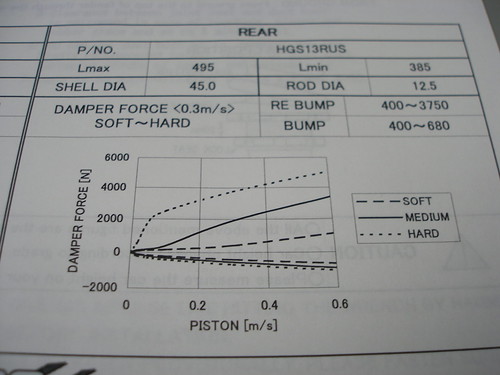
 |
|
|||||||
| Home | Rules & Guidelines | Register | Member Rides | FAQ | Members List | Social Groups | Calendar | Mark Forums Read |
| S Chassis Technical discussion related to the S Chassis such as the S12, S13, S14, and S15. |
 |
|
|
Thread Tools | Display Modes |
|
|
#1 |
|
Tanabe Pro 5 vs Tein (how to read shock dynos?)
Ok, so i was looking at coilovers. I know shock dynos mean a bit when it comes to handling and picking a good coilover system. I was looking at the Tanabe Pro 5 vs the Tein coilovers (FC3S one, just as an example). They both look like their dyno curves are different. It's a shame there is no more pro 7s from tanabe anymore.
I borrowed the documents from my buddys S14. He has the Tanabe Pro 5s. I found the Tein information online. Can some one explain how to read the charts? Just teach me the fundamentals so i can read future charts.  And, which one is "better" so to speak. I know some of the Teins are EDFC compatible. Are all the Tanabes TEAS compatible?    Thank you guys so much for the help! |
|
|
|

|
| Sponsored Links |
|
|
#4 |
|
Zilvia Junkie
 Join Date: Jan 2009
Location: Agoura Hills, Ca
Age: 31
Posts: 572
Trader Rating: (6)
 Feedback Score: 6 reviews
|
Its hard to effectively explain over the Internet without a serious writeup, but here it goes. This type of graph illustrates the movement of the piston in relation to the force being applied. One thing you must keep in mind when analysing these graphs is that they are not read like a hp/tq dynamometer. with this type of graph, neither one is better, its merely user preference. (Unless the spring rates are overly stiff, or the shocks are blown)These graphs are less of a way to for the manufacturer to analyze their own suspension than they are a way to inform the customer on the design and functionality of the coil over itself.
When referring to force, both companies use Newtons which is sort of an industry standard. one newton is about 0.224 809 pounds of force (lbf) or about 0.101 kilograms of force (kgf). Both distances are measured in minutes per second. The numbers below the line (in negative) represent rebound and the numbers above the line (positive) represent compression. When judging the graphs themselves, the specs seem to overlap for the most part, this is due inpart because of the 3 way adjustability of the Tunabe unit. In order to accurately compare the two products in relation to each other you must able to differentiate the front and rear. Front suspension components are typically always stiffer because of the amount of weight and load placed on them. A steep graph means that their is a greater amount of force required to move the piston where as a horizontal type line means that there is a reduction of force required to move the piston at the same rate at any given point. A term regularly used in relation to this information is initial force. Initial force is used to describe the amount of energy used to move an object that is stopped, for example the rear dampeners on the tein flex type coil overs have a high initial force in relation to the drift spec coil overs. But how does this reflect on your cars handling characteristics? to keep things simple, a high initial force/stiff dampener will result in a bumpy ride, much more suited for a track than a public road. A suspension setup such as this one will actually slow you down if used on anything other than a perfectly slick track, because it makes your car more susceptible to bumps. It would also help to know the piston and cylinder diameter of the Tein unit as this does have a factor in the effectiveness of the dampener. I would typically go with a larger shell diameter due to displacement of the load on the piston. As for the compatibility of the two products with electronic ride adjustment equipment, that is something i do not know, but you can always contact the manufacturer. Last edited by redsx13; 06-02-2009 at 10:27 PM.. |
|
|

|
 |
| Bookmarks |
| Thread Tools | |
| Display Modes | |
|
|